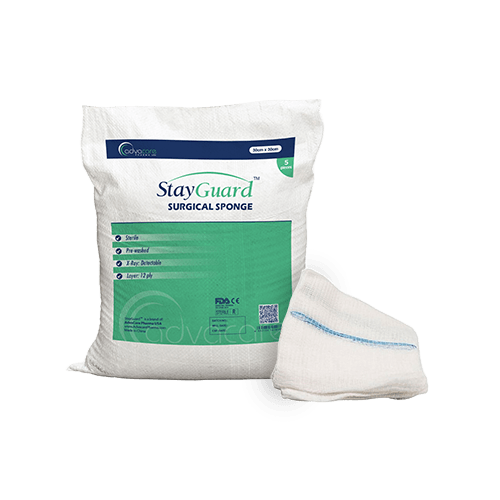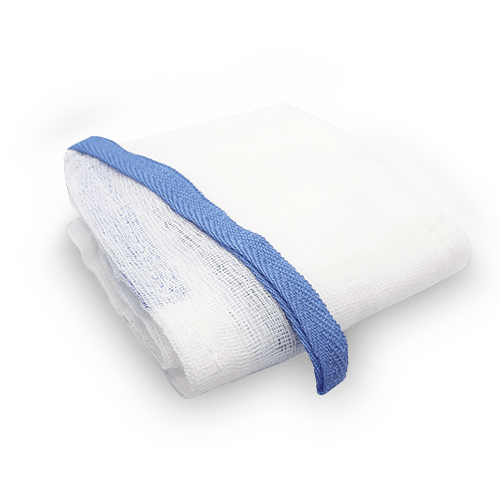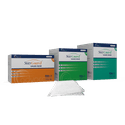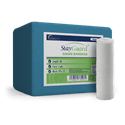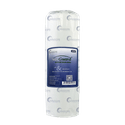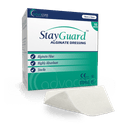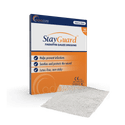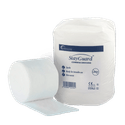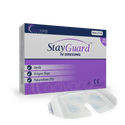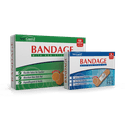- Home›
- Medical Devices›
- Skin & Wound Care›
- Wound Dressings›
- Surgical Sponge
Surgical Sponge
Size
Mesh
Yarn
Layer
X-Ray
Preparation
Handle
Color
Sterility
Packaging
What is a Surgical Sponge?
A Surgical Sponge is a sterile or non-sterile absorbent pad used in surgical procedures to absorb fluids and maintain a clean and dry surgical field. Surgical sponges are made of mesh or yarn and have x-ray detectable and undetectable variants. They come pre-washed or unwashed, and with or without radiopaque handles.
The absorbent nature of the surgical sponge, also called a lap sponge, helps to efficiently collect and manage fluids, minimizing the risk of contamination and keeping the surgical site clear. The availability of x-ray detectable and undetectable variants ensures that surgical sponges can be easily tracked and identified post-surgery, aiding in the detection of any potential retained sponges and preventing associated complications.
AdvaCare Pharma is a leading manufacturer of Surgical Sponges, and a wide selection of other medical gauze products for surgical use, that meet the highest quality and safety standards. Our products are manufactured in ISO and CE certified facilities in India, China, and the USA. We adhere to all applicable healthcare and regulatory guidelines, and we conduct regular inspections to ensure the quality and safety of our products.
Product Specifications
Mesh
Surgical sponges are crafted with a higher density of woven cotton, featuring a greater number of threads or yarns per inch in the fabric. This results in a tighter and finer weave, ensuring superior absorbency and excellent fluid retention capabilities. The high mesh count enables efficient cleaning and maintenance of a sterile surgical field.
Yarn
Surgical sponges are crafted using specific yarn counts to ensure optimal performance in medical settings. With a higher yarn count, like 40s yarn, these sponges offer a finer and smoother fabric, ideal for delicate procedures requiring gentle and precise handling. Conversely, a lower yarn count, such as 32s yarn, results in a slightly thicker sponge, providing enhanced absorbency and durability for more demanding surgical applications.
Layer
Surgical sponges, also known as lap sponges, are available in various ply options, each offering a different number of gauze layers. Thicker ply lap sponges consist of more layers, providing enhanced absorbency and padding for surgical procedures that require higher fluid absorption. Thinner ply lap sponges are suitable for lighter or more delicate procedures.
X-Ray
X-Ray Detectable lap sponges are crafted with integrated X-ray detectable threads within their multiple layers of gauze fabric. This feature ensures excellent visibility on X-ray images, facilitating easy identification during medical procedures and assisting in the detection of any inadvertently retained lap sponges after surgery. The layered construction provides optimal absorbency and padding for effective wound management, while the X-ray detectable property enhances patient safety by minimizing the risk of leaving any sponge remnants inside the body.
X-Ray Undetectable surgical sponges are carefully manufactured without any X-ray detectable components, making them ideal for non-surgical applications, including wound care, where X-ray visibility is not a primary concern. These sponges consist of multiple layers of absorbent and soft material.
Preparation
Pre-washed surgical sponges undergo a thorough cleaning or washing process prior to packaging, ensuring the removal of any residues, impurities, or contaminants that might be present on the sponge. This meticulous pre-washing procedure is performed to achieve a high level of cleanliness and sterility. By eliminating potential sources of contamination, pre-washed surgical sponges provide a reliable and hygienic option for various medical procedures.
Unwashed surgical sponges are packaged without undergoing any cleaning process, thus retaining their original state. These sponges may contain residues such as lint, fibers, or non-hazardous particles. It is important to note that unwashed sponges are not considered sterile and must be properly sterilized before use in surgical procedures. The absence of pre-packaging cleaning allows for flexibility in the cleaning and sterilization methods tailored to specific healthcare settings.
Handle
With Colored Radiopaque Handle surgical sponges offer enhanced visibility and safety in the operating room. The brightly colored handle ensures easy identification during procedures, while its radiopaque properties enable quick detection on imaging scans, X-rays, or fluoroscopy. This feature is crucial in locating and retrieving the sponge if it is unintentionally left inside the patient's body, reducing the risk of potential complications.
Without Colored Radiopaque Handle surgical sponges offer a reliable and versatile option for various medical procedures. While they lack the colored handle made of radiopaque material, these sponges still provide excellent absorbency and a soft, non-abrasive texture. Although they may not be easily visible on imaging scans or X-rays, they serve as a trusted tool for surgeons and medical professionals in achieving effective hemostasis and maintaining a clear surgical field.
Why are we a top Surgical Sponge manufacturer?
AdvaCare Pharma is a renowned exporter and manufacturer of high-quality medical supplies, including Surgical Sponges, with over 20 years of industry experience. Our strong partnerships with distributors, hospitals, NGOs, and pharmacies across 65 markets globally reflect our unwavering dedication to delivering excellence and meeting customer needs.
At AdvaCare Pharma, we prioritize the manufacture of surgical sponges (lap sponges), and other wound dressings for surgical procedures, that are quality-assured and cost-effective. Through our comprehensive StayGuard™ line of skin and wound care products, we continually strive to address the evolving demands of global communities.
Uses
How should a Surgical Sponge be used?
The correct use of surgical sponges is integral to preserving a sterile surgical environment and encouraging ideal patient outcomes:
- Before beginning any procedure, stringent adherence to aseptic techniques is paramount. Healthcare professionals should wash hands thoroughly and don sterile gloves to prevent contamination.
- When selecting a surgical sponge, considerations such as size, absorbency, and sterility must align with the requirements of the surgical procedure.
- Upon opening the sterile packaging, care should be taken to handle the sponge with sterile instruments or gloved hands to avoid introducing contaminants.
- Throughout the surgery, strategically placing the surgical sponge within the operative field aids in absorbing blood, fluids, and debris, thereby ensuring a clear surgical site and elevating visibility for the surgical team.
- Regularly replacing saturated sponges with fresh ones helps to maintain ideal absorbency and prevent the pooling of fluids, reducing the risk of infection.
- After the procedure, disposal of used sponges in designated medical waste containers is imperative to prevent cross-contamination and aid in compliance with infection control protocols.
What considerations are made when selecting Surgical Sponges for different surgical procedures?
When selecting surgical sponges for various surgical procedures, several considerations should be taken into account to assure their efficacy and compatibility with the surgical setting:
- Assessing the anticipated level of fluid absorption and the size of the operative field is required to determine the appropriate size and absorbency capacity of the surgical sponges.
- Factors such as the duration of the procedure and the extent of tissue manipulation also influence the selection process, with longer or more complex surgeries typically requiring larger and more absorbent sponges.
- Considering the patient's medical history, allergies, and sensitivities to materials commonly found in surgical sponges is required to prevent adverse reactions or complications.
- Evaluating the sterility status of the sponges is paramount, with sterile variants being preferred to minimize the risk of surgical site contamination and postoperative infections.
- Collaborating closely with the surgical team and adhering to institutional guidelines guarantees the selection of suitable surgical sponges tailored to the specific requirements of each surgical case, optimizing patient safety and surgical outcomes.
FAQs
How do Surgical Sponges work in surgical procedures?
Surgical sponges are highly absorbent pads used to soak up blood, fluids, and other secretions during surgeries. They help maintain a clean and dry surgical field by preventing contamination and providing clear visibility for the surgical team.
What distinguishes your Surgical Sponges from other brands and what are their key features and benefits?
Our surgical sponges are designed with features that prioritize safety, efficiency, and patient comfort. Some key features and benefits include:
- High absorbency to effectively manage fluids and exudate during surgeries.
- Non-linting and non-adherent material to minimize the risk of contamination and tissue trauma.
- Sterile packaging to ensure cleanliness and reduce the risk of surgical site infections.
- Available in various sizes and configurations to meet the diverse needs of surgical procedures and patient populations.
What is the difference between Mesh and Yarn Surgical Sponges?
Mesh surgical sponges are made of loosely woven fabric, allowing for better breathability and fluid absorption. Yarn surgical sponges, on the other hand, have a tighter and more closely woven construction, providing enhanced strength and durability. The choice between the two depends on the specific requirements of the surgical procedure and the desired level of absorbency.
What is the difference between X-Ray Detectable and Undetectable Surgical Sponges?
X-ray detectable surgical sponges contain materials, such as radiopaque threads or clips, that make them visible on X-ray images. This feature helps in identifying any retained sponge fragments after surgery. Undetectable surgical sponges do not contain such materials and are commonly used in procedures where X-ray visibility is not required.
What is the difference between Prewashed and Unwashed Surgical Sponges?
Prewashed surgical sponges have undergone a cleaning process before packaging, which removes impurities and makes them ready for immediate use. Unwashed surgical sponges, on the other hand, require thorough cleaning or sterilization by healthcare professionals before use.
Can I order customized packaging for your Surgical Sponges?
We offer a range of packaging options for surgical sponges to accommodate the preferences of local healthcare providers. However, it is crucial to assess the cost implications of different packaging materials to maintain the affordability of medical devices in each market.
References
Surgical Sponge - an overview
The article "Surgical Sponge - an overview" provides a comprehensive insight into the world of surgical sponges, shedding light on their pivotal role in modern surgical practices. Delving into the intricacies of these great tools, the overview meticulously details the diverse uses, materials, and functions of surgical sponges within the realm of surgical procedures. By elucidating the various types of sponges available and their specific applications, this resource serves as a valuable guide for healthcare professionals seeking to optimize their surgical techniques.
Furthermore, it underscores the significance of selecting the appropriate sponge material to ensure optimal performance and patient safety during surgical interventions. Overall, this overview serves as a foundational resource for understanding the indispensable nature of surgical sponges in the operating room and their indispensable contribution to successful surgical outcomes.

You might be interested in...
Why AdvaCare Pharma?
As an industry leader, we are aware of our responsibility to provide affordable and sustainable solutions to improve healthcare worldwide.
